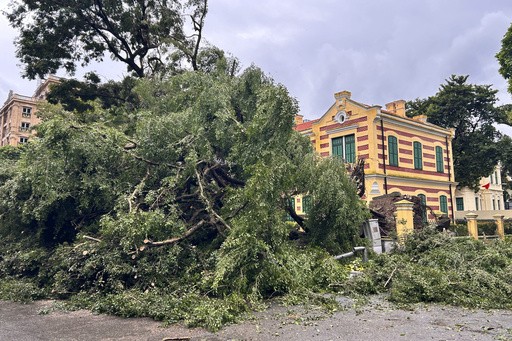In Vietnam, Typhoon Yagi caused significant devastation in the country’s northern region. Reports from state media indicated that the typhoon resulted in the loss of at least 14 lives and left 176 individuals injured. Despite its diminishing strength, officials cautioned about heavy rainfall that could persist following the typhoon’s impact.
Vietnamese authorities characterized Typhoon Yagi as one of the most forceful storms to strike the area in the past decade. The aftermath of the typhoon left over 3 million people in northern Vietnam without electricity and caused considerable harm to crucial agricultural areas, affecting nearly 116,192 hectares where staple crops like rice and fruits are cultivated. Travel was also heavily disrupted, with hundreds of flights canceled due to the closure of four airports.
After making landfall in the northern coastal provinces of Quang Ninh and Haiphong with wind speeds reaching up to 149 kilometers per hour (92 miles per hour) on Saturday afternoon, the typhoon persisted for approximately 15 hours before gradually degrading into a tropical depression early Sunday morning. The country’s meteorological department issued forecasts of intense rainfall in northern and central provinces, advising caution against potential floods in low-lying areas, flash floods in streams, and landslides on steep terrain.
In the capital city, Hanoi, cleanup efforts were underway by municipal workers, supported by the army and police forces, as they worked to remove uprooted trees, fallen billboards, toppled electricity poles, and damaged rooftops. Structural assessments of affected buildings were also being conducted to evaluate the extent of the damage.
Before reaching Vietnam, Typhoon Yagi formerly held its status as a storm while passing over the northwestern Philippines and the South China Sea. Its prior path resulted in the loss of at least 20 lives and left 26 individuals missing mainly due to landslides and widespread flooding in the nation. Subsequently, the typhoon moved on to China, where it caused three fatalities and nearly 100 injuries before impacting Vietnam.
Benjamin Horton, the director of the Earth Observatory of Singapore, commented on the increasing strength of storms like Typhoon Yagi, attributing it to climate change. Warmer ocean temperatures, he explained, provide more energy to fuel storms, resulting in higher wind speeds and heavier rainfall.


